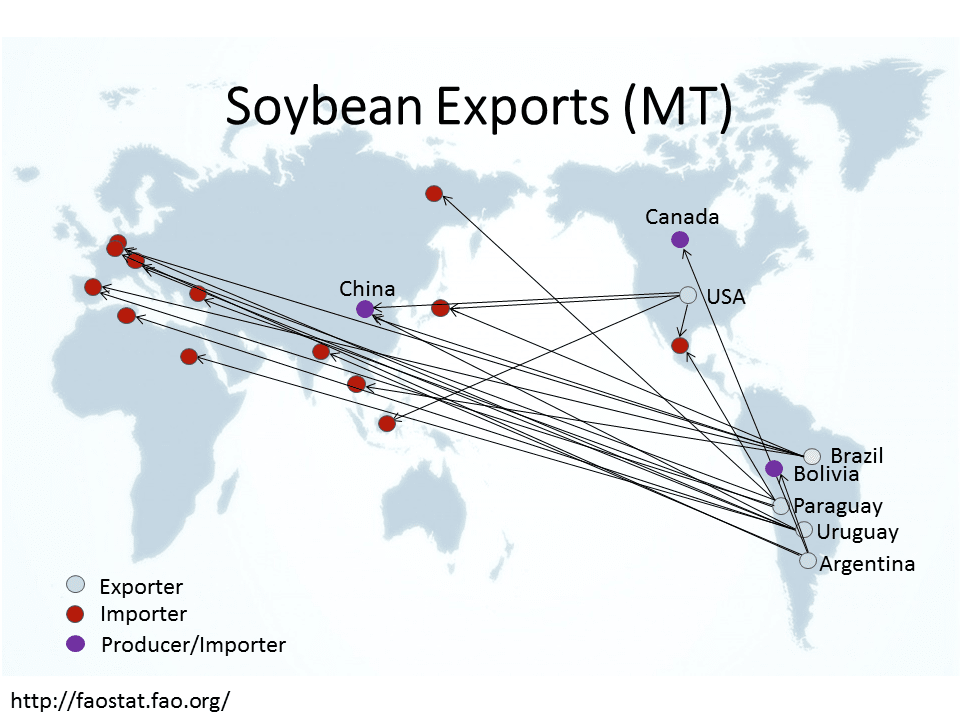Quantifying telecoupled human and natural systems using network analysis methods
|
In our increasingly globalized society, numerous interactions among humans and ecosystems occur over large geographic distances. The telecoupling framework, which suggests distant landscapes are increasingly influential to local processes, provides useful grounds for characterizing such dynamics. Although this recently-developed framework has gained prominence and momentum, rarely have the nuances of telecoupled systems been quantified. Network analysis is a powerful and flexible tool for measuring connectivity in various forms; it has been applied in social and economic settings, as well as studies of landscape habitat continuity and species population dynamics.
|
Global soybean trade as a telcoupled system
|
The shifting patterns of global soybean imports and exports have had far-flung social and ecological consequences, providing an excellent opportunity to explore telecoupled systems. Global land use for this commodity crop has doubled over the past 30 years, while most other crops remained steady. Increasing global demand for soybean and derivatives has been fueled by population growth, increased wealth, and higher meat consumption.
|
Network analysis methods to quantify telecoupled systems
We are using network analysis to quantify spatial, temporal and multi-scale dynamics associated with global soybean trade from 1986-2013, involving 126 countries. Network analysis, an application of graph theory (Urban and Keitt 2001, Fortin et al. 2012), is a versatile approach that can be used to describe how different components of social and ecological systems are connected. A network consists of a set of nodes, which are connected by edges representing the flows or interactions among nodes (Urban and Keitt 2001, Fortin et al. 2012). Various metrics can describe the degree to which the network facilitates or impedes the flow of organisms and materials (Taylor et al. 1993) or connectivity among social agents (Borgatti et al. 2009). Network analysis is flexible to inclusion of spatial and aspatial data, continuous and nominal attributes, and both anthropogenic or natural flows that may be of interest for complex telecoupled systems.
Below are two examples of how these methods can be used. At left is an example of assessing the relative importance of key soybean trading countries in 2013 in terms of the total soybean that they produced and exported. It is also possible to assess the strength and directionality of export flows from each country to major consuming countries, as shown at right for the year 2013.
Below are two examples of how these methods can be used. At left is an example of assessing the relative importance of key soybean trading countries in 2013 in terms of the total soybean that they produced and exported. It is also possible to assess the strength and directionality of export flows from each country to major consuming countries, as shown at right for the year 2013.
Acknowledgements
This work is a collaboration between early career researchers who met at the US-IALE meeting in Anchorage, Alaska in 2014. Funding for meeting attendance by the project team was provided by the NASA-MSU Professional Enhancement Program.
Borgatti, S. P., A. Mehra, D. J. Brass, and G. Labianca. 2009. Network Analysis in the Social Sciences. Science 323(5916).
Fortin, M.-J., P. M. A. James, A. MacKenzie, S. J. Melles, and B. Rayfield. 2012. Spatial statistics, spatial regression, and graph theory in ecology. Spatial Statistics 1:100–109.
Liu, J., V. Hull, M. Batistella, R. deFries, T. Dietz, F. Fu, T. W. Hertel, R. Cesar Izaurralde, E. F. Lambin, S. Li, L. A. Martinelli, W. J. McConnell, E. F. Moran, R. Naylor, Z. Ouyang, K. R. Polenske, A. Reenberg, G. de M. Rocha, C. S. Simmons, P. H. Verburg, P. M. Vitousek, F. Zhang, and C. Zhu. 2013. Framing sustainability in a telecoupled world. Ecology and Society 18(2).
Taylor, P. D., L. Fahrig, K. Henein, and G. Merriam. 1993. Connectivity is a vital element of landscape structure. Oikos 68(3):571–573.
Urban, D., and T. Keitt. 2001. Landscape connectivity: a graph‐theoretic perspective. Ecology 82(5):1205–1218.
Fortin, M.-J., P. M. A. James, A. MacKenzie, S. J. Melles, and B. Rayfield. 2012. Spatial statistics, spatial regression, and graph theory in ecology. Spatial Statistics 1:100–109.
Liu, J., V. Hull, M. Batistella, R. deFries, T. Dietz, F. Fu, T. W. Hertel, R. Cesar Izaurralde, E. F. Lambin, S. Li, L. A. Martinelli, W. J. McConnell, E. F. Moran, R. Naylor, Z. Ouyang, K. R. Polenske, A. Reenberg, G. de M. Rocha, C. S. Simmons, P. H. Verburg, P. M. Vitousek, F. Zhang, and C. Zhu. 2013. Framing sustainability in a telecoupled world. Ecology and Society 18(2).
Taylor, P. D., L. Fahrig, K. Henein, and G. Merriam. 1993. Connectivity is a vital element of landscape structure. Oikos 68(3):571–573.
Urban, D., and T. Keitt. 2001. Landscape connectivity: a graph‐theoretic perspective. Ecology 82(5):1205–1218.







